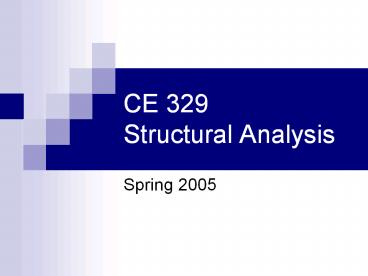CE 329 Structural Analysis - PowerPoint PPT Presentation
Title:
CE 329 Structural Analysis
Description:
CE 329 Structural Analysis Spring 2005 Objectives General List Course Objectives Describe Topical Coverage for Class Provide the Formula for Computing your Course ... – PowerPoint PPT presentation
Number of Views:376
Avg rating:3.0/5.0
Title: CE 329 Structural Analysis
1
CE 329Structural Analysis
- Spring 2005
2
Objectives ? General
- List Course Objectives
- Describe Topical Coverage for Class
- Provide the Formula for Computing your Course
Grade - Meet somebody new!
3
Objectives ? Analysis Fundamentals
- Define the role of analysis in the design of
structures - List the equations of equilibrium for a planar
structure - Compute the resultant and centroid for a system
of forces acting on a structure
4
Objectives ? Analysis of Planar, Statically
Determinate Structures
- Draw free body diagrams (FBDs) for idealized
support conditions - Solve for support reactions using equilibrium
equations - Define the Principle of Superposition and list
the assumptions needed for it to be valid - Compute the response of a structure with inclined
supports and/or forces acting at an angle other
than perpendicular to the axis of a member
5
Objectives ? Analysis of Planar, Statically
Determinate Structures
- Assess whether a structure is externally stable
or unstable - Identify whether a structure is statically
determinate or indeterminate - Compute the degree of indeterminacy for
statically indeterminate structures
6
Objectives ? Truss Analysis
- Summarize the assumptions used to analyze trusses
- Compute the determinacy of a planar truss
- Determine truss member forces using the method of
joints - Identify zero force members
7
Objectives ? Truss Analysis
- Compute truss member forces using the method of
sections - Recognize which analysis method is appropriate
for a given truss analysis problem
8
Objectives ? Beam Analysis
- Compute internal axial force, shear force, and
bending moment distributions in beams - Draw axial force, shear force, and bending moment
diagrams for general beam loading and support
conditions - Develop mathematical relationship between shear
and moment along the length of a beam - Calculate inflection points on a moment diagram
9
Objectives ? Frame Analysis
- Draw axial force, shear force, and bending moment
diagrams for general loading and support
conditions for a frame
10
Objectives ? Deflections
- Derive the Moment-Area Theorems
- Compute beam deflections using moment-area
principles - List the assumptions and limitations of using the
moment-area theorems to compute deflections
11
Objectives ? Deflections
- Compute deflections/rotations for structures with
overhangs, hinges, and/or changes in stiffness
using the moment-area theorems - Apply the moment-area theorems to compute
deflections/rotations in frames
12
Objectives ? Deflections
- Derive expressions that relate external virtual
work to internal virtual work - Calculate displacements and/or rotations using
the unit dummy load method (i.e., virtual work
principles) - Evaluate virtual work integrals using a graphical
procedure
13
Objectives ? Deflections
- Calculate displacements in beams using the unit
dummy load method (i.e., virtual work
principles) - Calculate displacements in frames using the unit
dummy load method (i.e., virtual work principles)
14
Objectives ? Deflections
- Calculate displacements in trusses using the
unit dummy load method (i.e., virtual work
principles) - Compute truss displacements accounting for
initial imperfections and thermal effects
15
Objectives ? Statically Indeterminate Structures
- Explain why statically indeterminate structures
are used for most applications - Summarize different analysis approaches used to
compute the response of statically indeterminate
structures - Apply the Flexibility (Force) Method to compute
reactions and internal forces in statically
indeterminate structures.
16
Objectives ? Statically Indeterminate Structures
(Flexibility Method)
- Define flexibility coefficient, redundant,
primary structure - Describe the procedure for establishing equations
of compatibility
17
Objectives ? Statically Indeterminate Structures
(Flexibility Method)
- Apply the Flexibility (Force) Method to compute
reactions and internal forces in statically
indeterminate trusses - Distinguish between trusses that are statically
indeterminate internally versus externally
18
Objectives ? Statically Indeterminate Structures
(Flexibility Method)
- Analyze statically indeterminate structures that
are subjected to support settlements - Analyze statically indeterminate trusses that are
subjected to thermal effects and/or initial
imperfections (i.e., fabrication errors)
19
Objectives ? Statically Indeterminate Structures
(Moment Distribution)
- Compare/Contrast static indeterminacy and
kinematic indeterminacy - Analyze statically indeterminate structures using
the method of Moment Distribution - Define the following terms
- Member Stiffness Factor
- Fixed End Moment
- Carry-Over Factor
- Degree of Freedom
- Distribution Factor
20
Objectives ? Statically Indeterminate Structures
(Moment Distribution)
- Analyze statically indeterminate structures with
simple supports and/or overhangs using the method
of Moment Distribution - Utilize modified stiffness coefficients to
analyze structures with simple supports at their
ends - Apply the method of moment distribution to
analyze frames that cannot sway
21
Objectives ? Influence Lines
- Describe what Influence Lines represent
- Construct influence lines for statically
determinate structures - Determine the positioning of a moving live load
to produce the maximum value for a reaction,
shear, or moment at a given location
22
Objectives ? Influence Lines
- Construct influence lines for statically
determinate structures qualitatively (i.e.,
without setting up equilibrium equations) using
the Muller-Breslau Principle
23
Objectives ? Influence Lines
- Determine the maximum effect (shear, moment, or
reaction) at a point due to a series of
concentrated loads































